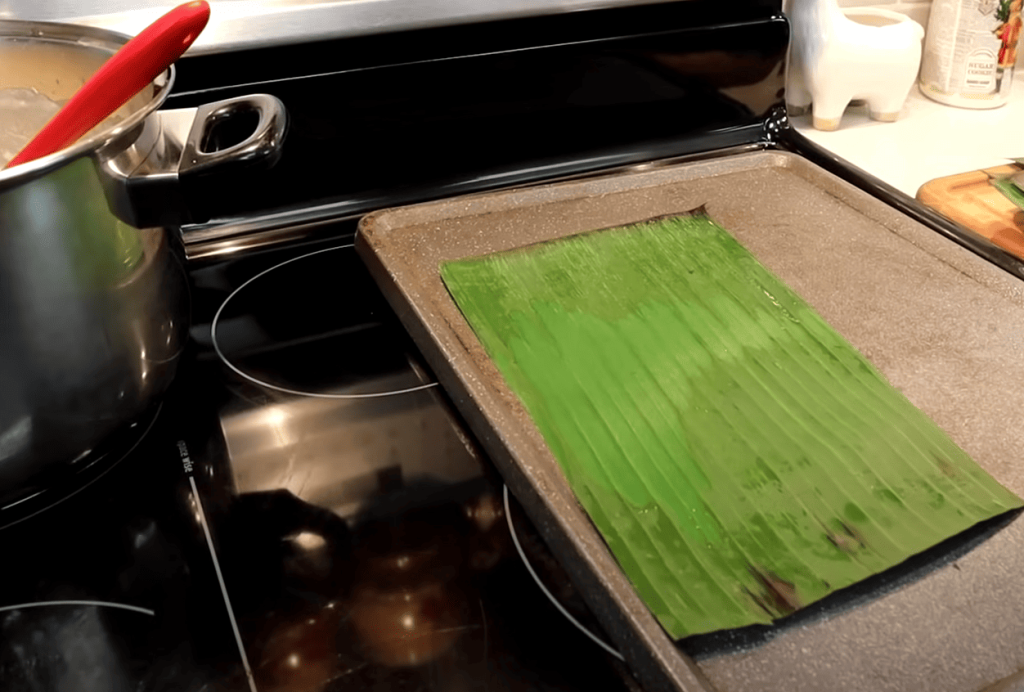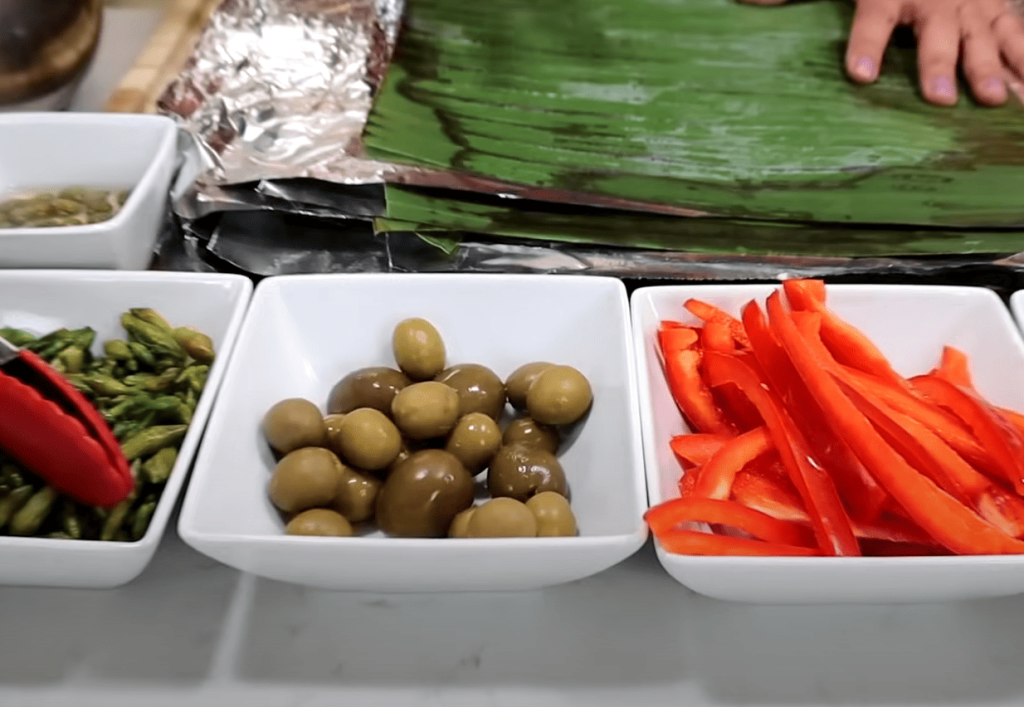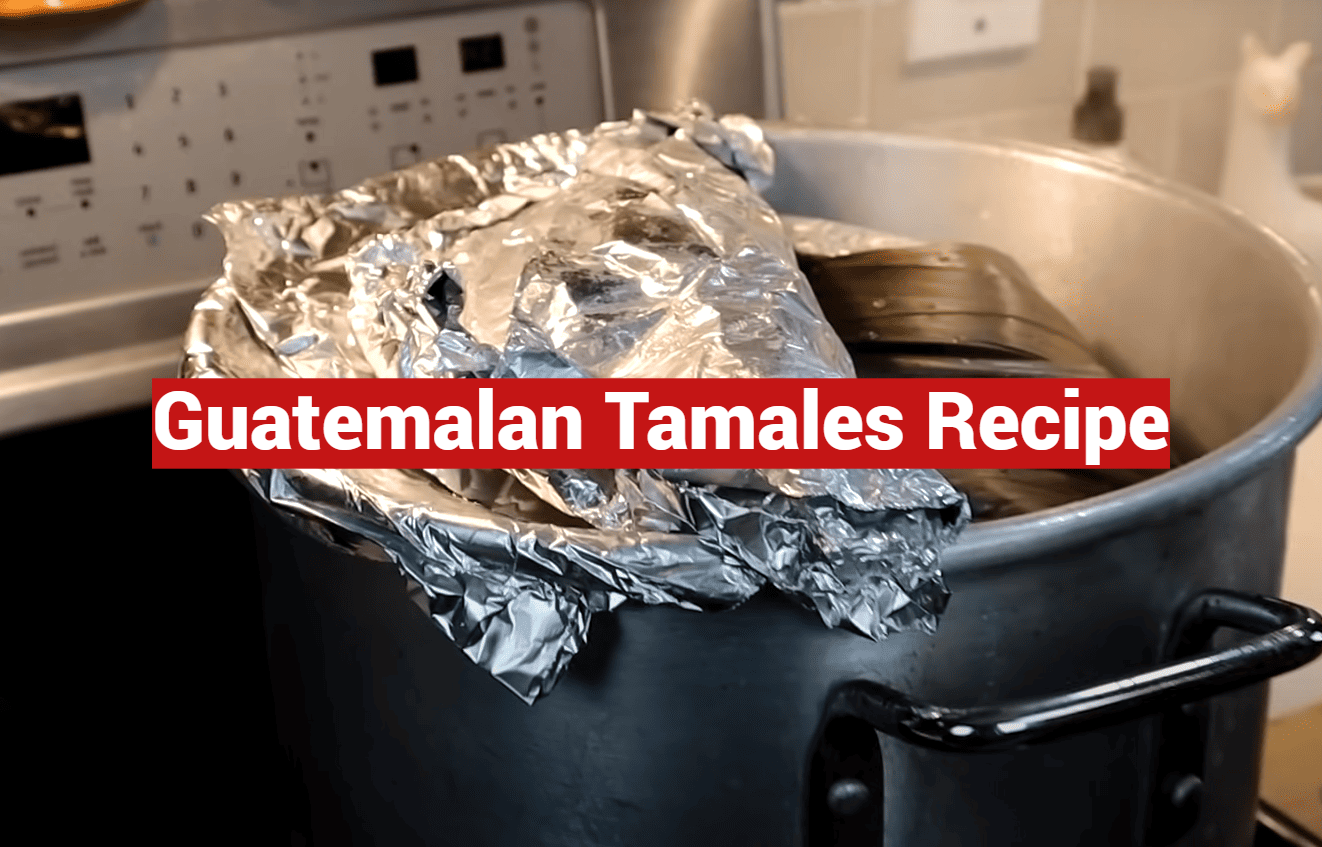Every Saturday, over 2 million households across Guatemala light red lanterns to signal a beloved tradition: fresh tamales steaming in banana leaves. This vibrant custom transforms neighborhood markets into aromatic wonderlands where families gather to share meals wrapped in history.
Our kitchen-tested guide unlocks the magic behind these flavor-packed bundles that have warmed hearts for generations. Unlike their Mexican cousins, these specialties feature a crimson-hued recado sauce and tender masa steamed in nature’s perfect wrapper – fresh banana leaves.
While crafting these treasures requires patience, the process becomes a joyful ritual. You’ll master techniques perfected through centuries of family traditions, from balancing spices in the signature red sauce to folding leaf packets like a pro.
Perfect for holiday feasts or weekend projects, this recipe turns your kitchen into a cultural crossroads. We’ve simplified ancestral methods without sacrificing authenticity, ensuring even first-timers can achieve that coveted restaurant-quality texture and complex flavor profile.
Key Takeaways
- Central American families celebrate weekly “tamale days” with visible red lantern displays
- Banana leaves and achiote-based sauce create distinct flavors versus other regional varieties
- Multi-hour preparation becomes an opportunity for bonding and storytelling
- Step-by-step instructions demystify traditional masa preparation techniques
- Special occasion dish adaptable for modern home kitchens
Introduction and Cultural History
Long before becoming a weekend staple, these leaf-wrapped treasures began as portable fuel for ancient warriors. The Nahuatl word tamalli—meaning “wrapped package”—reveals their practical origins. Over centuries, this humble meal evolved into a culinary art form celebrating community ties.

The Origins of Guatemalan Tamales
Central America’s signature version stands out with its crimson-hued recado sauce and banana-leaf wrapping. Considered the country’s national dish, these bundles shine during Christmas Eve and other meaningful moments. Families often joke that making them requires “three days and twelve hands”—a nod to their labor-intensive preparation.
“The masa isn’t ready until it tells you stories,” says María López, a third-generation tamale maker from Quetzaltenango. “That’s when you know the love’s been kneaded in.”
Celebrating Tradition and Family
Weekend tamaladas transform kitchens into bustling workshops. Grandmothers teach teens to spread masa evenly, while aunts debate spice ratios. This multi-day process turns meal prep into memory-making:
| Region | Prep Time | Key Ingredients | Occasions |
|---|---|---|---|
| Central Mexico | 6-8 hours | Corn husks | Daily meals |
| Oaxaca | 1 day | Mole negro | Weddings |
| Guatemala | 3 days | Banana leaves | Holidays |
Modern families cherish these gatherings as much as the finished product. The rhythmic clatter of pots becomes a love language, preserving heritage one folded leaf at a time.
Essential Ingredients and Kitchen Tools
The foundation of these iconic bundles lies in carefully balanced components. Let’s unpack the building blocks that transform simple elements into cultural treasures.
Key Components: Corn Flour, Meat, and Recado
Corn flour forms the soul of the masa. Brands like Maseca deliver the ideal texture—light yet sturdy enough to hold fillings. For proteins, choose between juicy pork shoulder (boasts rich flavor) or chicken thighs (offers tender simplicity).
The vibrant recado sauce ties everything together. Blend tomatoes, tomatillos, and roasted red peppers with guajillo and pasa chiles. This creates the signature crimson hue and smoky-sweet depth.
Must-Have Supplies: Banana Leaves, Large Pot, and More
Fresh banana leaves are non-negotiable. Look for pliable, aromatic ones at Latin markets—they’ll perfume the masa while locking in moisture. A large pot with a steamer basket handles batch cooking efficiently.
| Tool | Purpose | Alternative |
|---|---|---|
| Banana leaves | Natural wrapper | Aluminum foil |
| 8-qt pot | Steaming base | Instant Pot |
| Wooden spoon | Masa mixing | Silicone spatula |
For 20 portions, you’ll need 4 cups of corn flour and 3 lbs of meat. Add green olives or roasted peppers as colorful accents. Gather friends—the process tastes better shared!
Preparing the Masa (Corn Dough)
Mastering the corn dough forms the foundation of every successful batch. This pliable mixture demands precision – too dry and it crumbles, too wet and it loses structure. Let’s explore the techniques that transform simple ingredients into silky-smooth perfection.
Mixing and Consistency Checks
Start by combining corn flour with room-temperature water in small increments. Add half-cup portions while kneading until the dough forms a dense ball. This gradual hydration prevents lump formation and ensures even texture.
Transfer the mixture to a large pot and whisk in more water until it resembles thick pancake batter. Constant stirring over medium heat becomes crucial here. As bubbles form, incorporate lard and salt – these additions create the signature rich flavor and glossy finish.
| Common Issue | Cause | Solution |
|---|---|---|
| Grainy texture | Insufficient mixing | Whisk vigorously for 5 extra minutes |
| Sticky masa | Excess water | Add 1 tbsp corn flour |
| Bland taste | Underseasoned | Adjust salt during cooking |
Test readiness using two methods: the peel test (dough releases cleanly from pot edges) and the water glass technique. Drop a spoonful into cool water – properly cooked masa holds its shape without dissolving. Perfect consistency feels like softened clay when pressed between fingers.
Remember: well-prepared dough should spread smoothly across banana leaves without tearing. If it resists spreading, return to the pot for 3-4 more minutes of cooking while stirring. Your patience rewards you with masa that cradles fillings like a culinary hug.

Crafting the Recado Sauce
The soul of these iconic bundles lives in their crimson recado sauce—a vibrant blend balancing smoky depth and sun-ripened sweetness. Let’s dive into the vibrant components and techniques that transform simple vegetables into this essential flavor foundation.
Ingredients and Flavor Profile
Start with plump tomatoes, tomatillos, and red peppers. Roasted garlic and onions build aromatic warmth, while guajillo and pasa chiles deliver subtle heat. Traditional cooks swear by sambo peppers for their fruity undertones—a signature touch in Central American kitchens.
Boil ingredients until skins loosen, about 12 minutes. Peel tomatoes carefully to avoid gritty flakes. “Smooth sauce starts with patient peeling,” says chef Rosa Méndez. “Those tiny flecks can ruin the texture.”
Blending and Thickening Techniques
Transfer softened veggies to a blender with black pepper and allspice. Pulse until silky—no chunks allowed. Pour through a strainer into your pan for double smoothness.
Simmer with melted lard 8-10 minutes, stirring constantly. Test thickness by coating a spoon—proper sauce clings like velvet. Too thin? Whisk in corn flour teaspoon by teaspoon until ribbons form when drizzled.
| Consistency Check | Sign | Solution |
|---|---|---|
| Perfect | Coats spoon evenly | Proceed to assembly |
| Too thick | Ripples hold shape | Add broth 1 tbsp at a time |
| Too thin | Drips quickly | Simmer 5 more minutes |
This rich recado becomes the flavor backbone, seeping into every layer during steaming. Master this step, and your leaf-wrapped creations will sing with authentic Central American character.
Cooking the Meat Filling
The sizzle of seasoned meat hitting a hot pan signals the heart of your leaf-wrapped creations. This step transforms simple proteins into flavor-packed treasures that meld with masa and sauce during steaming.
Pork vs. Chicken Options
Choose chicken for quicker cooking or pork for richer depth. Cut 3 lbs of boneless thighs or shoulder into 20 uniform cubes. Rub generously with salt – this simple seasoning amplifies natural juices.
| Protein | Flavor Profile | Cook Time | Texture | Best For |
|---|---|---|---|---|
| Chicken | Mild & versatile | 8-10 minutes | Tender | Quick meals |
| Pork | Rich & savory | 10-12 minutes | Juicy | Special occasions |
Heat 2 tbsp oil in a skillet until shimmering. Brown cubes in batches to avoid steaming. “Bone-in pieces add soul to the broth,” notes chef Elena Ramírez, “but boneless lets guests enjoy without fuss.”
Keep cooked meat warm in a covered dish. This maintains moisture while you prepare other components. Adjust heat levels – chicken reaches safe temps faster than pork (165°F vs 145°F).
Assembly and Wrapping Techniques
The final presentation of these leaf-wrapped delights depends on mastering techniques passed through generations. Let’s explore the art of creating neat packages that lock in flavors while steaming.

Preparing Nature’s Perfect Wrapper
Start by slicing the thick central vein of 20 banana leaves lengthwise. Cut another 20 into 12×8-inch rectangles. Boil all pieces 45 seconds to soften fibers and remove debris. Pat dry with clean towels.
Layer two leaves crosswise on your workspace. The bottom leaf provides structure, while the top rectangle forms the filling pocket. This double wrapping prevents leaks during cooking.
Filling and Folding Fundamentals
Scoop ½ cup masa onto the leaves. Press three fingers into the center to create a well. Nestle one meat piece inside, then add 2 tbsp recado sauce. Top with olives and roasted peppers for color contrast.
| Step | Tool | Pro Tip |
|---|---|---|
| Leaf prep | Kitchen shears | Cut with shiny side up |
| Filling | Ice cream scoop | Measure portions evenly |
| Folding | Butcher’s twine | Secure loose ends |
Fold the nearest leaf edge over the filling. Bring the far side toward you, creating a snug envelope. Tuck ends under the bundle for a polished look. Repeat until all portions become edible parcels ready for steaming.
Alternative Wrapping Solutions
When fresh banana leaves aren’t available, use heavy-duty aluminum foil. Though it lacks the grassy aroma, foil creates steam pockets effectively. Follow this comparison guide:
| Material | Aroma | Moisture Control | Eco-Friendly |
|---|---|---|---|
| Banana leaf | Earthy | Superior | Yes |
| Aluminum foil | Neutral | Good | No |
Remember: Whether using natural leaves or foil, tight wrapping ensures even cooking. Practice makes perfect – enlist helpers to turn this step into a fun group activity!
Proper Cooking and Steaming Process
The magic of perfectly cooked bundles lies in mastering the steam. This final stage transforms individual components into a harmonious dish through gentle heat and moisture control. Proper technique ensures masa absorbs flavors while maintaining its signature tender-yet-firm texture.
Steaming Guidelines and Time Management
Begin by placing a steam basket in your largest pot. Pour 2-4 cups of water beneath it—enough to generate vapor without submerging the basket. The water level should sit one finger-width below the rack for optimal results.
Line the basket with leftover banana leaf scraps. This natural cushion prevents sticking and infuses extra aroma. Arrange your wrapped creations upright like little soldiers, leaving breathing room between each parcel. Crowding causes uneven cooking.
| Pot Size | Water Needed | Steam Time |
|---|---|---|
| 8-quart | 3 cups | 75 minutes |
| 12-quart | 4 cups | 90 minutes |
Cover everything with remaining leaves before sealing the pot. Maintain medium heat—vigorous boiling wastes water faster than needed. Check liquid levels every 25 minutes, adding boiling water if necessary. A dry pot spells disaster!
Test doneness after 60 minutes by unwrapping one bundle. Perfect masa pulls cleanly from the leaf and springs back when pressed. If it sticks, steam 15 more minutes and retest. Your patience rewards you with packages that sing when opened.
Tips for Authentic Guatemalan Tamales
Perfecting these leaf-wrapped delights requires attention to detail that transforms good results into extraordinary ones. While the process might seem daunting at first, a few expert tricks ensure your creations capture the essence of Central American kitchens.
Best Practices for Consistency and Flavor
Always use fresh banana leaves – their natural wax coating releases aromatic oils during steaming. Wipe leaves with a damp cloth instead of rinsing to preserve these flavorful compounds.
Maintain steady steam by placing a coin at the pot’s bottom. The metallic rattle signals adequate water levels, while silence means you need to refill quickly. This clever hack prevents burnt pots and uneven cooking.
Let bundles rest 15 minutes after steaming. This allows masa to set properly, creating that signature tender-yet-firm texture. Test doneness by pressing gently – properly cooked dough springs back like memory foam.
For balanced flavors, layer recado sauce both under and over the meat filling. This double application ensures every bite bursts with smoky-sweet complexity. Share your creations while warm, wrapped in their fragrant leaves for an immersive cultural experience.


